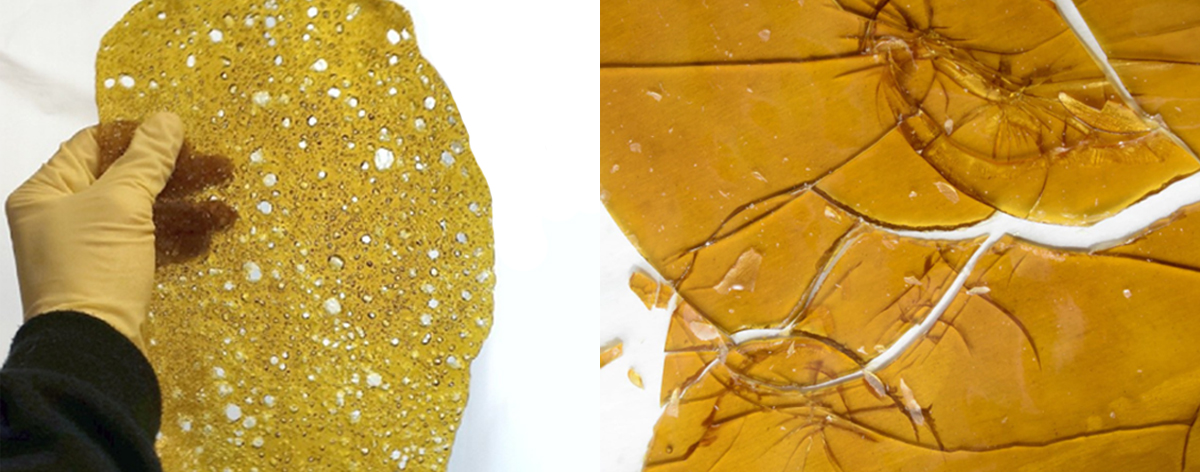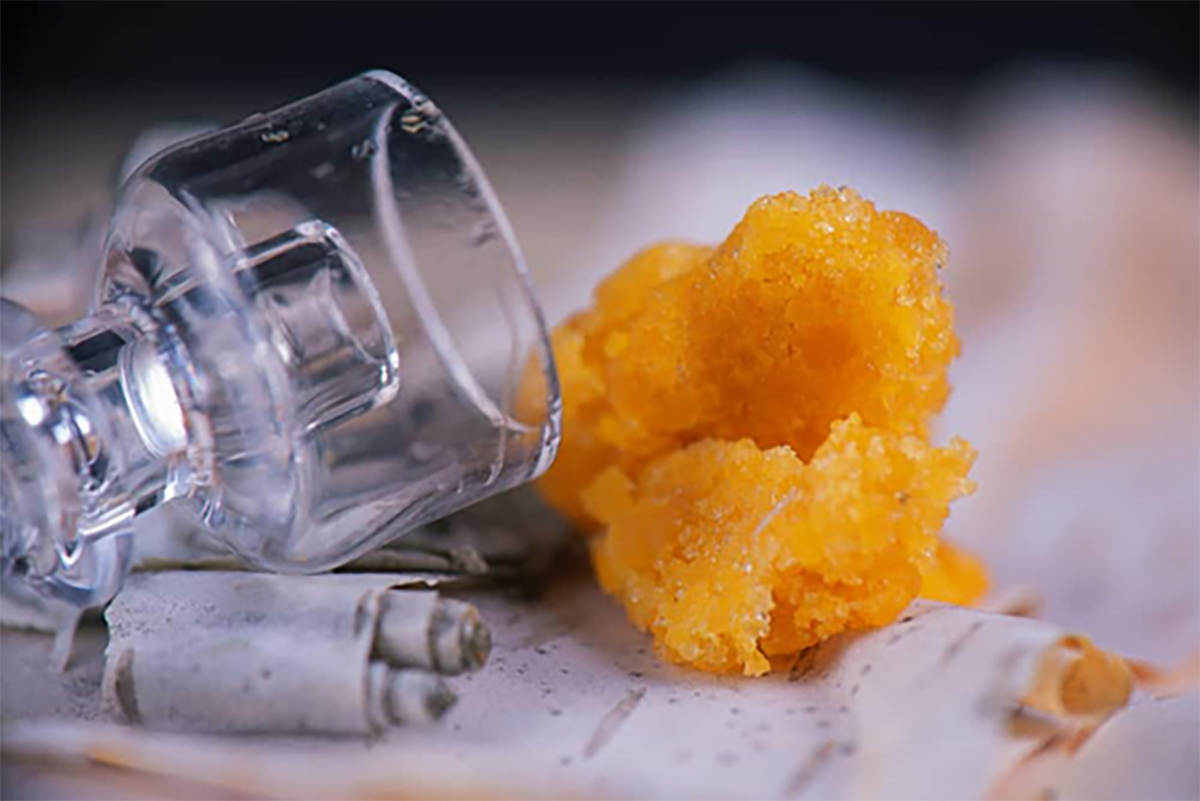Past blog articles on this site have waxed lyrical about cannabis e-liquids and juices for cannabis vaporizers, but they are not the only options for cannabis lovers. Cannabis concentrates, with thicker or heavier textures, can be great alternatives. The most popular concentrates include cannabis oil and cannabis wax, and this article will discuss the similarities and differences between the two.
What exactly is cannabis wax?
Cannabis wax is a more solid and opaque (i.e. less transparent) oily substance resulting from cannabis extraction. The molecules of cannabis wax have crystallized from agitation, resulting in irregular molecular densities. Since light can’t travel through such densities and is instead refracted, cannabis wax has lost its transparency. There are different consistencies in cannabis wax, depending on the temperature, moisture, and texture of the cannabis oil before residual solvents are removed. “Budder” refers to gummier waxes resulting from runny oils with higher moisture. The denser, more solid waxes that can be brittle to pressure are called “crumble” or “honeycomb”. Meanwhile, “pull-and-snap” wax has a taffy-like consistency, as it can stretch while it is pulled from the parchment container until it snaps. Finally, “shatter” is more solid and can be transparent (resembling amber-colored glass)—it shatters into pieces when pressure is applied.

How Cannabis Wax is Made?
Cannabis wax is made by extracting cannabinoids, such as THC (tetrahydrocannabinol) or CBD (cannabinoid) oil, from the cannabis plant using a solvent. The resulting concentrate is a waxy substance that is highly potent and can be used in various ways, such as vaporizing or dabbing. Here are the steps to make cannabis wax:
- Start with a high-quality cannabis strain that is rich in cannabinoids and terpenes. The strain can be either indica or sativa, depending on the desired effects.
- Use a solvent, such as butane or CO2, to extract the cannabinoids and terpenes from the cannabis plant. This process can be dangerous and should only be done in a well-ventilated area by experienced professionals.
- The solvent is then evaporated, leaving behind a sticky, waxy substance that is highly concentrated with cannabinoids and terpenes.
- The wax is then purged of any remaining solvents and contaminants using heat and pressure.
- The final product is a smooth, golden-colored wax that is highly potent and can be used in various ways, such as vaporizing or dabbing.
It’s important to note that making cannabis wax at home can be dangerous and should only be attempted by experienced individuals who are familiar with the process and have the necessary equipment. Improper extraction or purging can result in residual solvents or contaminants that can be harmful to consume. It’s best to purchase cannabis wax from a licensed dispensary or reputable supplier.
What about cannabis oil?
Cannabis oil is also a result of cannabis extraction, but it is more viscous and transparent, similar to essential oils or cooking oil. Like wax, cannabis oils come in different densities and viscosities, but it is always liquid (compared to wax, which is solid). Most oils found at dispensaries are produced through chemical extraction, which uses a solvent to extract cannabinoids, terpenes, and flavonoids, then add them to carriers like hemp oil or MCT (medium-chain triglyceride) oil. CO2 extraction, however, is becoming popular as it produces oil that is free from toxic residues, which occasionally result from chemical solvents. There are also many types of cannabis oil depending on the compounds it contains, such as THC (tetrahydrocannabinol) or CBD (cannabinoid) oil.
What are the differences between wax and oil?
Cannabis wax and oil are two popular types of cannabis concentrates that offer a more potent and flavorful experience than traditional smoking methods. Here are the differences between wax and oil:
- Texture: One of the main differences between wax and oil is their texture. Cannabis wax has a waxy, crumbly texture, while oil is a more viscous liquid.
- Potency: Wax is generally considered to be more potent than oil due to its higher concentration of cannabinoids and terpenes. This makes it a preferred choice for experienced cannabis users who want a stronger effect.
- Consumption method: Wax is typically consumed by vaporizing or dabbing, which involves heating the wax on a heated surface and inhaling the resulting vapor. On the other hand, oil can be consumed by vaporizing, dabbing, or even mixing it into foods or beverages.
- Flavor: Wax is known for its strong and complex flavor profile, which is often described as earthy, floral, or fruity. Oil, on the other hand, tends to have a more subtle flavor that is easier to mask when mixed into foods or beverages.
- Availability: Cannabis oil is more widely available than wax due to its easier production process and broader consumer appeal. However, both concentrates can be found at licensed dispensaries or from reputable suppliers.
- Storage: Cannabis wax is typically kept in wax or parchment paper or small containers, depending on the texture, while cannabis oil is regularly sold in bottles, often with droppers for dosing.
- Price: Another difference between wax and oil lies in their prices. As of 2019, wax (budder or crumble) would go for around $30 per gram, while shatter and pull-and-snap would cost approximately $40 to $55 per gram. Oil is slightly cheaper, with vape pen cartridges filled with cannabis oil ranging from $30-$60, while a 32ml tincture of THC oil would cost around $50-$60.
Ultimately, the choice between wax and oil comes down to personal preference and cannabis needs. While wax offers a more potent and flavorful experience, oil provides a more versatile and convenient consumption method. It’s important to purchase cannabis concentrates from a licensed dispensary or reputable supplier to ensure quality and safety.
Do they have similar effects on consumption?
Both cannabis wax and oil have similar effects when consumed. They both offer a more potent and concentrated experience than traditional smoking methods, and can produce a range of effects depending on the strain and dosage. The effects of both concentrates are generally felt within minutes of consumption and can last several hours.
While both wax and oil have higher concentrations of THC (up to 8 times) compared to cannabis buds, wax is purportedly purer and has more concentration, at around 80% to almost 100% pure THC. There is more THC for the same volume of cannabis wax compared to oil, and it is generally more potent and produces more intense effects. And since THC is the psychoactive compound in cannabis responsible for that euphoric “high” sensation, cannabis wax can get vapers more “stoned” quicker compared to oils.
How can cannabis vapers use cannabis wax and cannabis oil?
The most common method of consuming cannabis concentrates, which apply to both oils and waxes, is vaping. Vaping is not only efficient considering the higher temperatures required to evaporate oils and waxes but also discreet as the vapors are largely smokeless and odorless. For oil, disposable cartridges filled with THC or CBD oil are separately sold whether to be used with compatible batteries. Meanwhile, there are vaporizer pens to use specifically with waxes, consisting of a battery, an atomizer, and a mouthpiece. The cannabis atomizer, or the coil, includes a chamber where the wax is placed, then heated and vaporized. Different cannabis vaporizers include quartz coil atomizers, ceramic bowl atomizers, and quartz bowl atomizers. Quartz coils heat up faster and produce more vapor, while bowls produce less vapor but stronger flavors. Another method that can be used to consume both wax and oil is smoking them using bongs or “rigs” (modified bongs).
However, there are other ways of consuming cannabis oil, including sublingually (placing the oil under the tongue) using the dropper. Like vaping, this method allows the cannabinoids to be absorbed quickly into the bloodstream, resulting in a “high” effect. Another way of using cannabis oil is to make edibles like cookies and candy. These are then consumed through ingestion, which takes longer for the body to absorb (refer to other articles on this site about the advantages of edibles compared to vaping). Cannabis vapers have also used cannabis oil as a topical, although the efficacy of this method needs further research.

Should cannabis vapers choose cannabis wax or cannabis oil?
The differences laid out above should make the types of cannabis vapers more suited to cannabis wax than cannabis oil. The higher concentration of cannabis wax and its more intense effects make it more suitable for hardcore cannabis vapers. Not to mention, there are fewer methods to consume cannabis wax, most of which can be pretty messy and complicated. For cannabis vapers looking to access their cannabis quickly and easily, the amount of practice and familiarity required to handle wax vaporizers may not be ideal. Meanwhile, cannabis oil cartridge is less intense, with a greater variety of concentrations that cannabis vapers can try out. It is also much more user-friendly. The wide availability of disposable cannabis vape oil cartridges makes cannabis oil the better option for new users. Not to mention, cannabis oil is more versatile in use and can be handy to have around the house. Therefore, casual cannabis consumers should lean towards cannabis oil, leaving cannabis wax for the more experienced and dedicated cannabis connoisseurs.